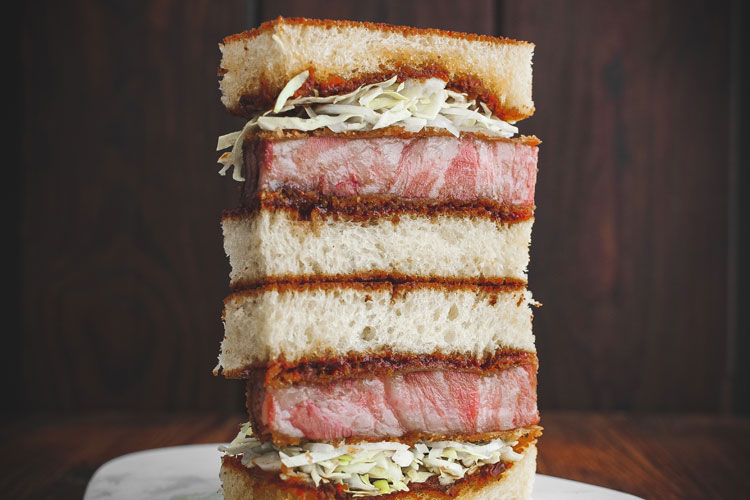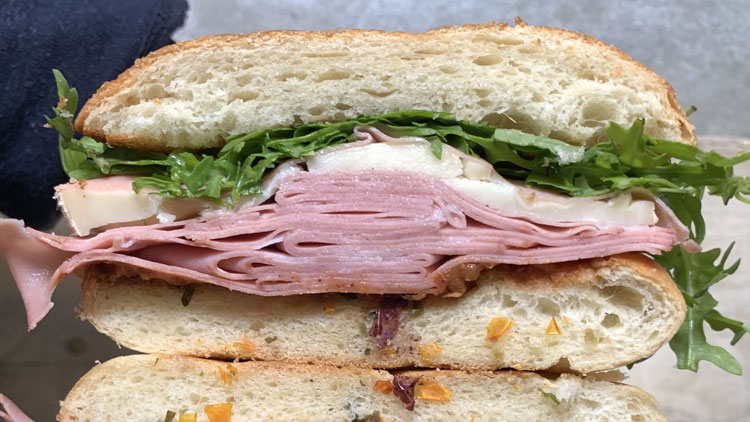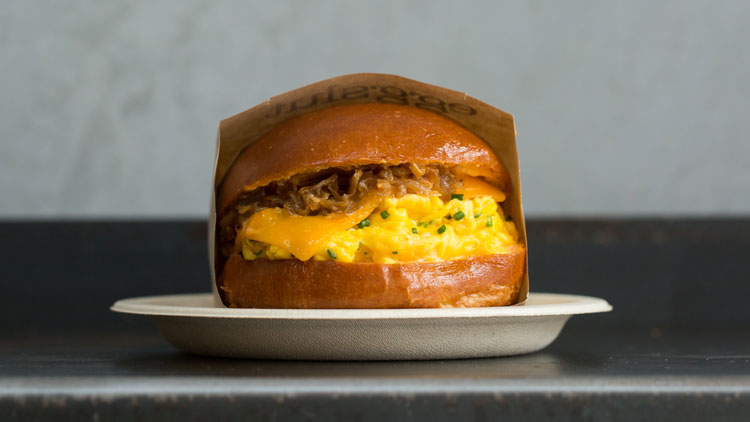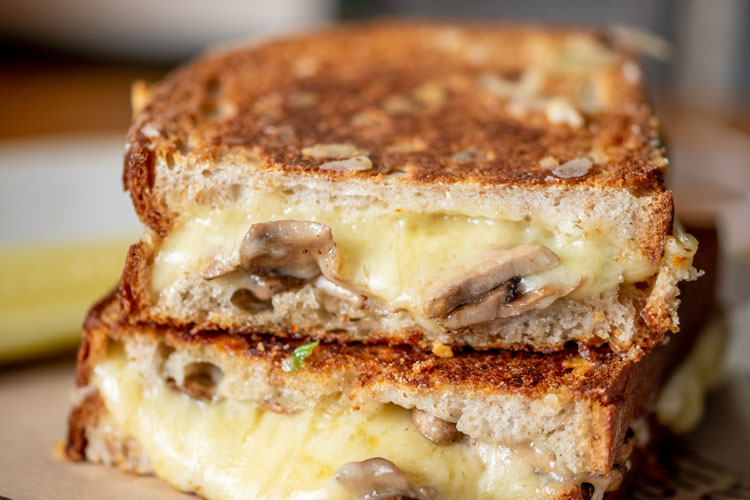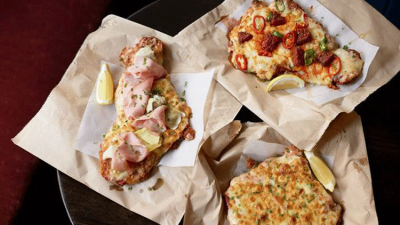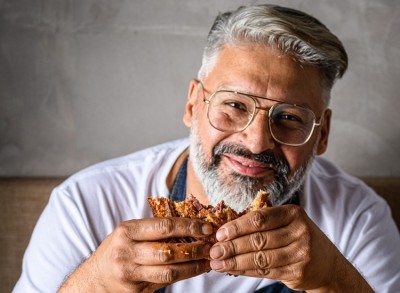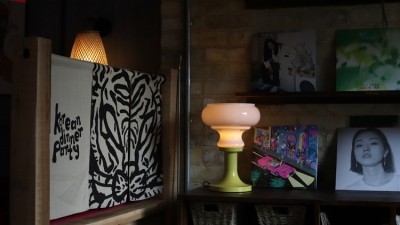Will the sandwich ever be the same again?
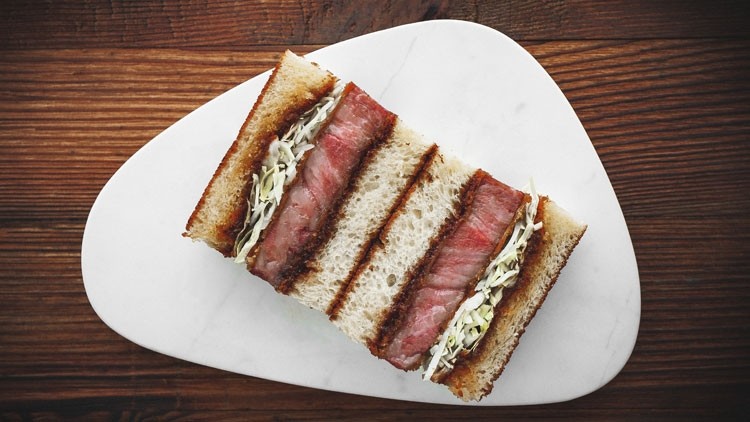
The hottest dish in London right now isn’t an aged Galician beef steak accompanied by a slowly melting thick layer of glistening fat; nor is it a whole turbot, cooked over charcoal so that its meat falls apart with the gentle pull of a fork. No, the hottest dish in London right now is a sandwich.
Admittedly, it isn’t an ordinary sandwich. For one it’s smaller, more akin to the delicate two-finger sandwiches reminiscent of those served by luxury hotel restaurants for afternoon tea than a more traditional doorstop. The filling is also puzzling; a slab of deep-fried pork neck on a bed of finely-shredded cabbage with some sort of raspberry brown sauce. Then there’s the presentation. Gone is the standard plastic or paper wrapper, not only is this sandwich served on a plate, it’s often laid out horizontal rather than vertical, as if toppled over. And finally, there’s the price; forget a three quid meal deal, this bijou beast will set somebody back £14.
Welcome to the katsu sando, the Japanese sandwich making waves across the capital thanks, largely, to TĀ TĀ Eatery founders Ana Gonçalves and Zijun Meng, whose aforementioned creation has been welcomed in some foodie circles as something of a second coming. Or, to put it another way: the best thing since sliced bread.
Described by Gonçalves as “a dirty posh sandwich”, the duo’s katsu sando is the centrepiece of their latest concept, Tóu, which opened at Centre Point’s new Arcade Food Theatre in London earlier this year. A fusion of Meng and Gonçalves’ Asian and Portuguese heritage, the sando features a giant hunk of Iberico pork that’s been breaded with a panko crumb and deep fried in lardo, before being salted and served between two thick slices of lightly toasted brioche that have already been topped with the shredded cabbage and raspberry sauce. The crusts are then removed, the sando cut in half widthways, and presented on the plate in a way that gives maximum visual definition to the individual layers of the sando.
“The classic sandwich has been a staple of the high street for years to the point where I think people are overfamiliar with it,” says Meng, describing what it was that spurred the sando’s creation. “We’d started to see operators play with the sandwich concept in a street food setting, but what we wanted to do was show that it could also fit into a restaurant environment.”
The pair first began selling it at a residency at Borough Wines in Kensal Rise, north-west London, in the summer of 2018, and it immediately caught the eye of the capital’s consumers. Sparking a city-wide obsession, pictures of the sando were soon plastered across Instagram, with foodies dubbing it ‘the best sandwich in London’.
Gonçalves and Meng both appear humbled by the response, but admit to not being overly surprised by the sando’s burgeoning popularity. “I think the reason it caught people’s attention is because it’s so different from what people are used to,” says Gonçalves. “The katsu sando isn’t just another sandwich, it’s a proper artisan dish that’s both visually striking and rich in flavour.”
“It would be priggish to pretend that we alone started this trend,” adds Meng, acknowledging other London restaurant operators that began selling the sando at around the same time. “I love experiencing different interpretations of it, like the ones from Bright or Two Lights, because they’re so different from ours. That’s what makes this dish so exciting, there are just so many possible variations.”
In many ways, the sando’s success feels like Gonçalves and Meng bringing their careers full circle. Back when they opened their first street food stall, they served another sarnie creation: the ‘ricewich’, made from slow-cooked brisket, kimchi mayonnaise, salad and coriander that was encased in sushi rice and wrapped in nori. It wasn’t a major success, and the pair struggled under the technical limitations of their street food stall. Would they consider bringing it back now they’ve established the potential for making sandwiches in a restaurant setting? “Never say never,” says Meng. “But for us it’s not really about trying to bring something back; it’s about trying to create something new.”
Sandwiches for dinner?
The rise of the sando is significant for two reasons. First, there’s the price point; at £14 it’s more expensive than a Byron burger with fries, and not even half the size. While not an unknown price to pay for a sandwich – the £25 club sandwich has long been a staple of five-star hotel room service menus for travellers battling with different time zones – the sando is aimed at a much wider, and younger, demographic.
Second is the fact that Gonçalves and Meng appear to have effectively reinvented the very idea of what a sandwich means to consumers in the capital. It’s no longer just about having a cheap grab-and-go snack to be hastily devoured during a 30-minute lunch break; available to order until late, the katsu sando is a sandwich that many diners are choosing to eat for their dinner.
“It makes sense to us,” says Gonçalves. “We’re starting to see a cultural shift. Younger generations are less interested in having a traditional sit-down dinner, and many are choosing small plates over the classic three-course meal set-up, which creates a space for concepts like this to thrive.”
Positioning the sandwich as a viable evening meal is something a number of London’s new wave of premium sandwich operators are keen to tap into. However, Gonçalves and Meng aren’t the first to successfully serve sandwiches for dinner.
Max Halley, ‘chief sandwicher’ at Max’s Sandwich Shop in north London’s Stroud Green, has proved – particularly in the past year or so – that serving a sandwich menu at the end of the day is feasible, having done so ever since he launched his business back in late 2014. It wasn’t always his plan to do so, though.
“It was the site that defined the idea for me,” says the ebullient Halley. It was 2013 when he first began thinking about opening his own sandwich shop, but back then the concept was much more conventional. “I was originally planning on doing a more traditionally artisan offering; lots of cured meats and smoked cheeses akin to the deli style you find in the US, but with better bread,” he says.
Halley had intended to open in Soho, thanks to the help of private investment, but pulled out at the eleventh hour. “It just didn’t make any sense to me. I’d wanted to open my own place, so I could be my own boss. Then, before I’d even launched, I’d given away half of the company.”
Soon after, he heard about a site close to Crouch Hill station that was available. He went to check it out and immediately fell in love with it, but it soon became apparent he was going to have to modify his concept. “It was designed to be a restaurant, not a café. I still wanted to serve sandwiches, but no one wants a tomato and basil baguette with some prosciutto at 7pm on a Friday night. So, I began to think about how I could transform the sandwich into something people would want to have for their dinner.”
Having consulted with some of his chef friends, Halley quickly discovered that most people still stuck to the classic BLT or coronation chicken when asked to list their favourite sandwich fillings. “It revealed something I didn’t expect. And I just thought fuck, no one is really interested in exploring sandwiches.”
For Halley, converting the sandwich into a viable evening meal meant adapting classic staple dinners. His first was the now famous ham, egg and chips – slow-cooked ham hock served on homemade focaccia bread and topped with piccalilli, a fried egg, shoestring fries and malt vinegar mayo. “For me it was all about taking meals that diners were comfortable with and adjusting the elements so it could fit between two pieces of bread. I thought that by serving sandwiches that were obviously a meal that would help people embrace the notion of having them for supper.”
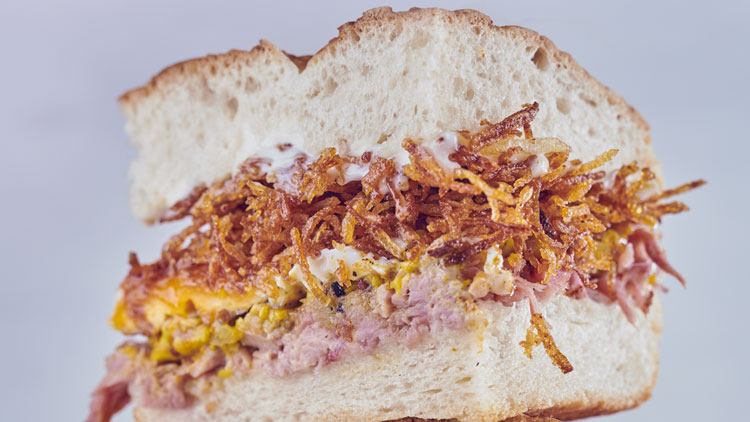
Following his “theory of deliciousness”– every sandwich is designed to encapsulate the same six elements, containing a cold, a hot, a sweet, a sour, a crunchy and a soft component – Halley created a menu initially featuring three sandwiches and a smattering of sides, accompanied by a menu of alcoholic drinks. It wasn’t an immediate success. On the first night it opened, he served two customers (“and one of them was for free”), but word slowly spread.
Priced at £9.50, his brand of deep-filled, novelty sarnies soon captured people’s imaginations (other classics on the menu have included a PBJ with peanut butter, streaky bacon and jalapeños; and one featuring braised short ribs, sauerkraut, deep-fried broccoli and ‘very slutty gravy mayo’) and the sandwich shop is now averaging around 800 covers a week; no small feat for a 28-seat restaurant that’s only open five days a week, and on three of those just in the evenings.
“Sandwiches are something that everyone is familiar with,” says Halley when asked why he thinks his business has become so popular. “Even when it has got weird shit in it, it’s still a sarnie at the end of the day and the comfort of that appeals to a lot of people.” He cites the success of Tu as a perfect example of this: “Trying to get people to eat a dish that consisted of deep-fried pork neck, raspberry jam and raw cabbage would be a tough sell. But bang it between two pieces of brioche and you’ve got an Insta phenomenon.”
Following the West and the East
It may seem like a new idea in London, but serving sandwich-like objects outside of lunchtime is commonplace in other food cultures – the prego, bocadillo, butifarra and croque monsieur are all served through the day and into the night in their countries of origin.
“The problem is that while we will happily enjoy burgers for dinner in the UK, we perceive sandwiches as being different because we all grew up having them for lunch,” says James Ramsden, who is hoping to tap into the evening market when he and business partner Sam Herlihy launch their sandwich bar Sons + Daughters in Coal Drops Yard, Kings Cross this month; a project the pair began working on more than a year ago.
Options on the Sons + Daughters menu will include a baguette with spicy lamb sausage, air-fries, pickled shallots, gremolata and mayonnaise; and a Swaledale chicken sandwich with pickled cucumber, miso mayonnaise, salsa verde, soy-cured parmesan, gem lettuce and wasabi cress that’s served on white bloomer. Both are hot, meaty options that Ramsden thinks will appeal as much to those at lunchtime as those who visit in the evening.
Given his and Herlihy’s background, though, which saw them open idiosyncratic high-end restaurant Pidgin together back in 2015, and later Magpie in Mayfair – which was forced to close less than two years after opening following “struggles” with footfall – the burning question is, why turn to sandwiches?
“We’d been looking around at London’s dining scene, and what we saw was a lot of people that appeared to be struggling,” says Ramsden. “As a result, more and more were beginning to move away from the traditional restaurant model and into the fast-casual arena, and the idea to focus on sandwiches fundamentally grew from there.
“Unlike with other recently emerging food trends, there’s still plenty of space in London’s sandwich market for brands to raise their profile. For us, Sons + Daughters is an opportunity to try to do for the humble sarnie what Byron did for burgers, or what Franco Manca has done for pizzas.”
Ramsden is confident diners will embrace the idea, but accepts that the premium price point – sandwiches at Sons + Daughters will cost between £7.50 and £9.50 – could pose a problem. “The sandwich is interesting as there’s a roof on what you can charge,” he says. “People have an expectation when it comes to the price of a sandwich, and the struggle for all of us is going to be changing people’s minds. Deconstruct a premium sandwich filling onto a plate and most people will be willing to pay a little bit more for it, but put it in between bread and people suddenly expect it to be cheaper.”
Challenging the price ceiling
The first packaged sandwiches to be sold in Britain cost around 43p, although that was back in the spring of 1980. Made by Marks & Spencer as part of an experiment to test the market, they consisted of basic fillings like egg and cress or prawns with mayonnaise, were served on triangles of white bread, and presented in plastic cartons. To some, the notion of trying to charge customers for something they could just as easily make at home seemed downright bizarre, but it was soon apparent that the idea had struck a chord with consumers.
Fast forward around 40 years and Brits now buy more than 3.5 billion sandwiches annually, and the market is worth close to £8bn. But tastes have moved on from cheese and pickle and tuna mayonnaise – sandwich makers have continued to innovate, with the likes of Pret a Manger and Eat experimenting with less traditional sandwich fillings and flavours.
But over the past few years it’s the indies that have really upped the ante on sandwich development. These days you can get subs with scallops courtesy of Sub Cult; a grilled cheese with mushroom and truffle from Morty & Bob’s; and if you head over to Eggslut on Portobello Road, you can find a brioche bun packed with slices of wagyu tri-tip steak and topped with a fried egg. Prices are well north of a fiver.
A rising price point is highlighted as a principle concern by many of London’s sandwich operators. “Asking people to spend more than a tenner on a sandwich is never going to go down that well,” says Charlie Phillips, founder of premium fast-casual restaurant brand and grilled-cheese specialist Morty & Bob’s, who himself will be looking a take a bigger bite out of the evening sandwich market when the brand launches its first dedicated sandwich bar at Westfield London in Shepherds Bush later this year.
“However, by using the right ingredients, the sandwiches will speak for themselves. Forget staples like egg and cress, in the evenings it’ll be about slow-cooked lamb shoulder with salsa verde and lamb crackling, served on focaccia and with a lamb jus on the side to dip.”
The question that remains is whether, as has happened with burgers and pizzas, the current sandwich spike is a fad or something more long term. London’s love of sandwiches is well-documented, but as the recent closure of Monty’s Deli’s flagship restaurant in Hoxton suggests, not everyone is flourishing in this apparently thriving market (although the brand is about to bounce back with the opening of another site, in KERB’s Seven Dials Market).
“A sandwich is ostensibly a broad canvas,” says Phillips, dismissing suggestions that this is just another trend: “I think it’ll just keep growing. The past has demonstrated that the sandwich is a strong genre, and we’ve already seen it go from something you would only have at home, to M&S, to Pret, and now to the more premium market we see today.
“I suspect you’ll see quite a lot of people jumping on this in time, and with it I think there’s a real opportunity for high-end restaurants to not only appeal to a broader range of customers, but also offer their existing clientele something that is perhaps a little more casual. There’s a huge growth in adaptable fast-casual dining, and sandwiches can play a big role in this.”
Ramsden agrees. “It’s a busy sector,” he says, “but if you look closely you can see that everyone is doing something a little bit different. This is nice as while we want to see the concept continue to flourish, we don’t want to see the mass homogenisation of the [new wave of] sandwich. The reason so many have turned to it recently is because there’s such great breadth.”
Halley is equally upbeat about the future of the sandwich, and foresees a further blossoming of the bloomer. “Hopefully the next stage in the evolution of the sandwich will see the bottom end of the market improving too,” he says.
“In terms of the premium end, god only knows what someone will want to put between two slices of bread in the future, but it would be great to see an upping of the game across the board, particularly on the industrial end; moving away from something that’s cheap towards something that’s well, delicious.”
This is a web version of an article that first appeared in the September issue of Restaurant magazine, the leading title for the UK's restaurant industry. For more features, comment, interviews and in-depth analysis of the restaurant sector subscribe to Restaurant magazine here.
